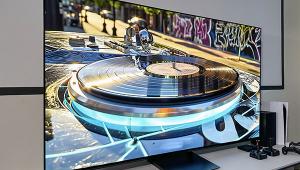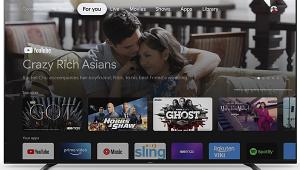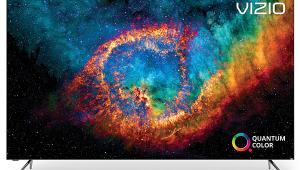Samsung QN65Q90R LCD Ultra HDTV Review Test Bench
For the picture settings used during viewing, visit soundandvision.com. The measurements here were made using CalMAN software from Portrait Displays, together with Photo Research PR-650 and Klein K-10A color meters and a Fresco Six-G test pattern generator from Murideo/AVPro.
HD/SDR
Full-On/Full-Off Contrast Ratio: 153,800:1
With the Backlight set to 26, local dimming on Standard (the default), and Contrast at 35 in Movie Picture mode, the measured peak white level on a 10% full white window was 44.9 foot-lamberts after calibration (153.8 nits). A full black screen was nearly unmeasurable at 0.001 nits (the ragged edge of our Klyne meter's accuracy), resulting in the above contrast ratio.
With Warm2 Color Tone and the above settings selected, the pre-calibration grayscale Delta E from 20% to 100%, was a maximum of 2.91 at 30%. Post-calibration using only the 2-point White Balance controls, the maximum Delta E was 2.2 at 30%. The maximum color Delta E was 3.48 (in red) before calibration in the Auto Color Space setting, and 3.12, also in red, after calibration. Green, cyan, magenta, and yellow all had Delta Es under 2.0 both before and after calibration. With the Gamma control at the BT.1886 setting (with the BT.1886 adjustment on 0), the Gamma ranged from 2.26 at 20% to 2.3 from 50% to 80%.
(Delta E is a figure of merit indicating how close the color comes to the D65 HD standard at each point in the brightness range. Values below 3—some experts allow for 4—are generally considered visually indistinguishable from ideal.)
UHD/HDR
Full On/Full Off Contrast Ratio: Unmeasurable
With the Samsung's Contrast setting at the default 50, the EOTF (gamma) curve skewed hot above about 50%. Bringing Contrast down to 39 for both the before and after readings produced a more accurate EOTF. This setting was increased to 42 for some of the comparative viewing tests.
With the Backlight set to 50, Brightness to 0, Contrast to 39, Gamma on BT.1886 (BT.1886 adjustment on 0), Local Dimming on High, the measured peak white level on a 10% white window was 1,300 nits and the black level toggled between 0.001 nits and 0.000 nits. But it was mostly the latter, rendering the Full On/Full Off Contrast ratio essentially unmeasurable.
In the Warm2 Color temperature and the above settings, the post calibration grayscale Delta E never exceeded 2.1 without luminance included, and the color Delta E never exceeded 3.5 (in red, at 50% color saturation and 50% luminance). Complications in the menu ergonomics discussed in the review prevented dialing in a tighter tolerance, but the average Delta E for all primary and secondary colors was a respectable 2.9 (again at 50% saturation and 50% luminance) and the visible result was excellent. A color checker analysis, which measures dozens of different colors, resulted in an average Delta E of 2.09 with luminance included and 1.85 without luminance.
With a 2% white window, and a Contrast setting of 39, the luminance measured 800 nits with a 2% peak white window, 1,000 nits with a 5% window, 1,300 nits with a 10% window, 1,200 nits with a 25% window, and 500 nits with a 100% full field white window. The color tracking in BT.2020 was fair, P3 within a BT. 2020 window was fair to good, and BT.709 within a BT.2020 window very good.
The Q90R reached 72.9% of BT.2020 and 94.2% of P3 (using the 1976 standard for both), slightly below the best we've yet measured on those parameters with other TVs.
The Samsung passed all of our standard video tests for deinterlacing, clipping, and luma and chroma resolution.



























































